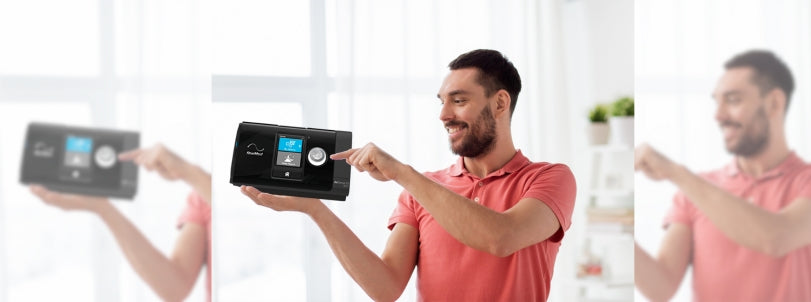
What Pressure is Right? Customizing Your ResMed CPAP Machine Settings
Obstructive sleep apnea is caused by an obstruction in the upper airways. CPAP treats the disorder by supplying a continuous stream of pressurized air while you sleep. This helps keep the airways free of obstruction and prevents the mini-arousals that can see you waking up gasping for air.
The ResMed CPAP machine settings help determine the pressure of the air you inhale and exhale while you sleep. But how do you know the appropriate pressure setting for the severity of your obstructive sleep apnea, and can you customize your ResMed CPAP machine settings? We’ll outline some options below.
What Is the Correct Pressure Setting for Your CPAP Device?
When you start CPAP, your device will be set with a pressure setting prescribed by your healthcare provider. This setting is determined by a sleep study and based on your apnea-hypopnea index (AHI). This index relates to the frequency of your breathing pauses caused by obstructive sleep apnea.
CPAP pressure settings generally range between 6 and 14 cmH20, with 10 cmH20 being the average. Inhaling and particularly exhaling against pressurized air can be difficult, and your healthcare provider will tend to recommend a pressure setting at the lowest end of the scale that will still keep your airways free of obstruction.
Therefore, the pressure setting is customized based on the severity of your sleep apnea. Prescribed pressure settings should only be changed in consultation with your healthcare provider. However, they may need adjusting over time.
Signs Pressure Settings Need Adjusting
CPAP can take a period of adjustment for new users. However, if you continue to struggle with the air pressure setting, you should consult your healthcare provider. They may be able to lower the pressure setting to make it easier to tolerate, providing it does not cause a return of your breathing pauses.
A pressure setting that is too low or too high could cause issues that threaten compliance and will need addressing.
1. Pressure Too Low
When the pressure setting is too low, the air delivered by CPAP will struggle to keep your airways open. Another sleep study may be required, and if it reports you are experiencing five or more sleep apnea episodes every hour, it is a signal that the pressure setting needs to be higher. Snoring can also be a sign that the airways are becoming blocked because the pressure is set too low.
2. Pressure Too High
If the pressure is set too high, the resulting discomfort can make breathing difficult. This can make it harder to sleep and thereby reduce the effectiveness of CPAP. As well as discomfort in the mouth, high-pressure settings can cause a burning sensation in the throat and ears.
Expiratory Pressure Relief
Exhaling against a prescribed pressure setting can be the element that CPAP users struggle with the most, with breathlessness becoming an issue. However, expiratory pressure relief (EPR) is another option within the ResMed CPAP machine settings. EPR allows you to set a different, lower-pressure setting for when you exhale. The air pressure returns to your prescribed setting when you inhale. As with the pressure settings, the EPR setting can be customized to the individual.
The popular ResMed AirSense 10 device has four EPR settings, with 0 indicating no pressure relief on exhaling. You can use the ResMed CPAP machine instruction manual to customize the EPR setting.
However, your EPR setting could be prescribed by your healthcare provider, and it is therefore always worth consulting them before making such adjustments.
Another comfort feature of the ResMed AirSense 10 device is the AutoRamp facility. With AutoRamp, you can customize your ResMed CPAP machine settings to start delivering air at a lower pressure than prescribed.
This can be particularly useful for people new to CPAP who are finding it difficult to adjust to the pressurized air. A lower-pressure setting when you first go to bed can make it easier to fall asleep.
The CPAP device detects when you are asleep through your breathing patterns and will ramp up the pressure to your prescribed setting to ensure you continue to gain all the benefits of CPAP.
Auto-Adjusting Devices
Compliance is key for reducing or even eliminating the symptoms of obstructive sleep apnea and improving the quality of your sleep. If tolerating the stream of fixed air pressure delivered by CPAP continues to be an issue, your healthcare provider may recommend an APAP device such as the ResMed AirSense 10 AutoSet.
APAP stands for automatic positive airway pressure. An APAP device uses your breathing patterns to automatically adjust the pressure of the air you inhale and exhale. It measures the resistance in your breathing to deliver the amount of pressure required to keep your upper airways open.
When an APAP device detects an event that reduces airflow, it increases the pressure level before lowering again when appropriate. It achieves this by monitoring the device user’s breathing patterns breath-by-breath.
If you find it easier to tolerate APAP compared to the fixed pressure supplied using a CPAP device, you don’t have to forgo treatment for obstructive sleep apnea when away from home.
The compact ResMed AirMini travel device also includes the AutoSet feature. If you are a regular traveler, a travel device makes compliance with APAP, BiPAP or CPAP therapy simpler when on the go. This portable device takes up less precious luggage space than a standard device.
The degree of obstruction experienced and the severity of obstructive sleep apnea will vary from person to person. The right pressure for ResMed CPAP machine settings is one prescribed by a healthcare provider from data supplied by a sleep test. Your CPAP device will be configured with this prescribed setting.
ResMed CPAP machine settings will be customized to the appropriate setting for the user. However, they may need adjusting if the pressure setting is too low or too high. Changing the settings yourself using the ResMed CPAP machine instruction manual could see them set too high in either direction and risk the return of your sleep apnea symptoms. This should only be done in consultation with a healthcare provider to ensure the continued effectiveness of your CPAP therapy.
